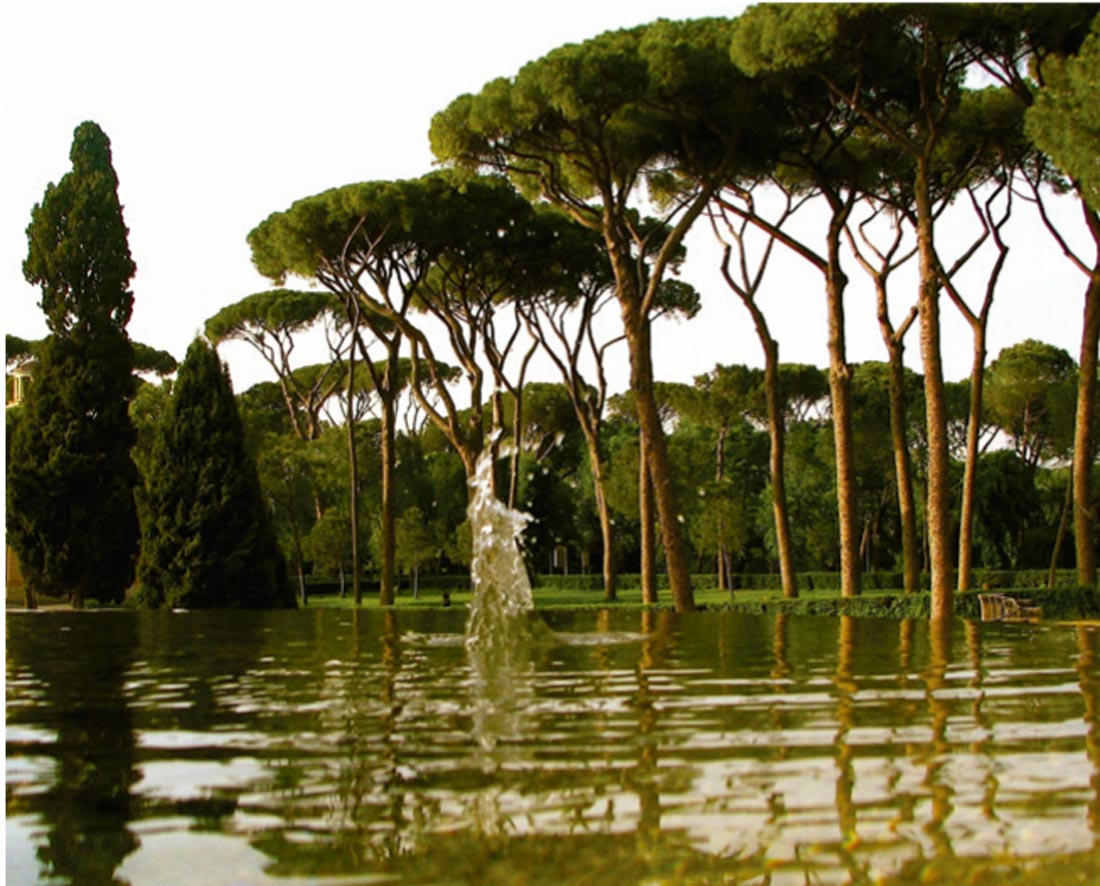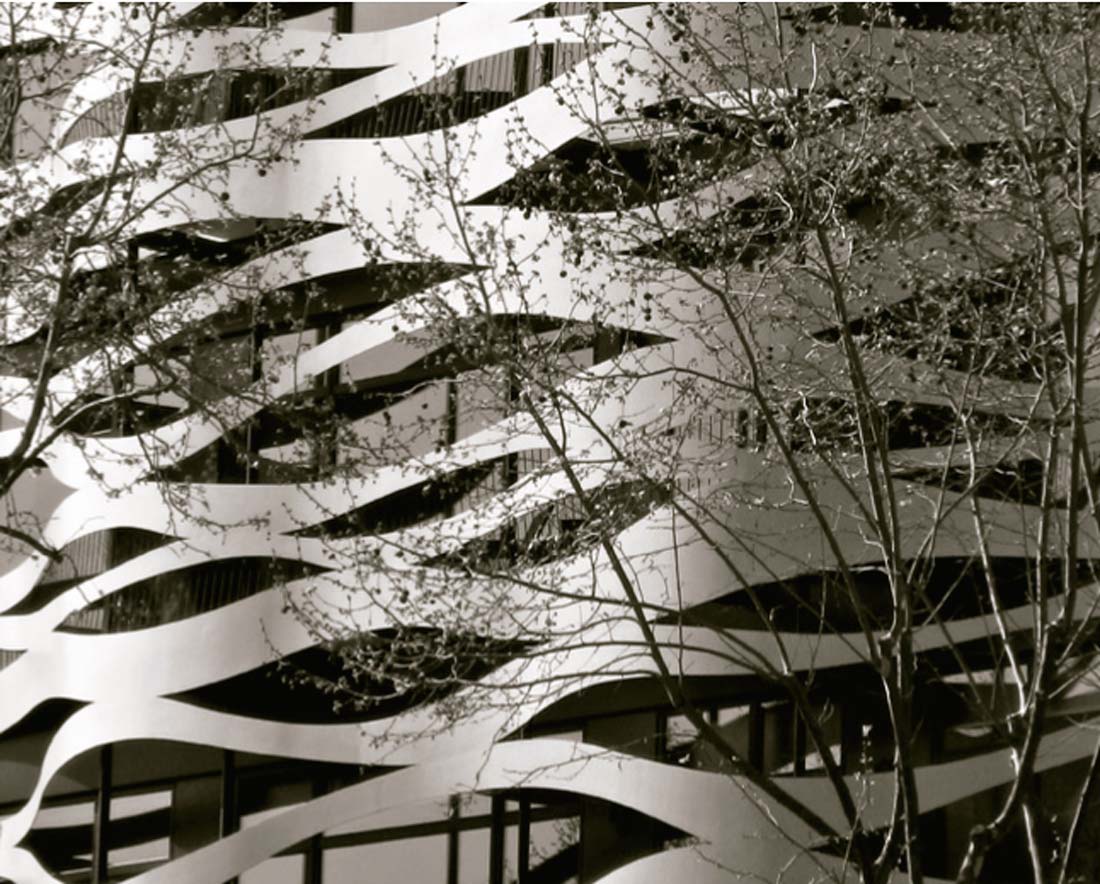Biophilic design can reduce stress, enhance creativity and clarity of thought, improve our well-being and expedite healing; as the world population continues to urbanize, these qualities are ever more important. Theorists, research scientists, and design practitioners have been working for decades to define aspects of nature that most impact our satisfaction with the built environment. “14 Patterns of Biophilic Design” articulates the relationships between nature, human biology and the design of the built environment so that we may experience the human benefits of biophilia in our design applications.
NATURE-DESIGN RELATIONSHIPS
Biophilic design can be organized into three categories – Nature in the Space, Natural Analogues, and Nature of the Space – providing a framework for understanding and enabling thoughtful incorporation of a rich diversity of strategies into the built environment.
Canopy trees and water features of the Vatican City gardens. Image © Valentina A/Flickr
Nature in the Space
Nature in the Space addresses the direct, physical and ephemeral presence of nature in a space or place. This includes plant life, water and animals, as well as breezes, sounds, scents and other natural elements. Common examples include potted plants, flowerbeds, bird feeders, butterfly gardens, water features, fountains, aquariums, courtyard gardens and green walls or vegetated roofs. The strongest Nature in the Space experiences are achieved through the creation of meaningful, direct connections with these natural elements, particularly through diversity, movement and multi-sensory interactions.
Nature in the Space encompasses seven biophilic design patterns:
1. Visual Connection with Nature. A view to elements of nature, living systems and natural processes.
2. Non-Visual Connection with Nature. Auditory, haptic, olfactory, or gustatory stimuli that engender a deliberate and positive reference to nature, living systems or natural processes.
3. Non-Rhythmic Sensory Stimuli. Stochastic and ephemeral connections with nature that may be analyzed statistically but may not be predicted precisely.
4. Thermal & Airflow Variability. Subtle changes in air temperature, relative humidity, airflow across the skin, and surface temperatures that mimic natural environments.
5. Presence of Water. A condition that enhances the experience of a place through seeing, hearing or touching water.
6. Dynamic & Diffuse Light. Leverages varying intensities of light and shadow that change over time to create conditions that occur in nature.
7. Connection with Natural Systems. Awareness of natural processes, especially seasonal and temporal changes characteristic of a healthy ecosystem.
Façade renovation of Suites Avenue Aparthotel by Toyo Ito, Barcelona, Spain, is biomorphic in form, while enhancing the Dynamic & Diffuse light and shadows filtering to the interior space. Image © Aslai/Flickr
Natural Analogues
Natural Analogues addresses organic, non-living and indirect evocations of nature. Objects, materials, colors, shapes, sequences and patterns found in nature, manifest as artwork, ornamentation, furniture, décor, and textiles in the built environment. Mimicry of shells and leaves, furniture with organic shapes, and natural materials that have been processed or extensively altered (e.g., wood planks, granite tabletops), each provide an indirect connection with nature: while they are real, they are only analogous of the items in their ‘natural’ state. The strongest Natural Analogue experiences are achieved by providing information richness in an organized and sometimes evolving manner.
Natural Analogues encompasses three patterns of biophilic design:
8. Biomorphic Forms & Patterns. Symbolic references to contoured, patterned, textured or numerical arrangements that persist in nature.
9. Material Connection with Nature. Materials and elements from nature that, through minimal processing, reflect the local ecology or geology and create a distinct sense of place.
10. Complexity & Order. Rich sensory information that adheres to a spatial hierarchy similar to those encountered in nature.
Stepping stones at the Foth Worth Water Garden, Forth Worth, Texas. Image © Jay/Flickr
Nature of the Space
Nature of the Space addresses spatial configurations in nature. This includes our innate and learned desire to be able to see beyond our immediate surroundings, our fascination with the slightly dangerous or unknown; obscured views and revelatory moments; and sometimes even phobia-inducing properties when they include a trusted element of safety. The strongest Nature of the Space experiences are achieved through the creation of deliberate and engaging spatial configurations commingled with patterns of Nature in the Space and Natural Analogues.
Nature of the Space encompasses four biophilic design patterns:
11. Prospect. An unimpeded view over a distance, for surveillance and planning.
12. Refuge. A place for withdrawal from environmental conditions or the main flow of activity, in which the individual is protected from behind and overhead.
13. Mystery. The promise of more information, achieved through partially obscured views or other sensory devices that entice the individual to travel deeper into the environment.
14. Risk/Peril. An identifiable threat coupled with a reliable safeguard.
NATURE-HEALTH RELATIONSHIPS
Much of the evidence for biophilia can be linked to research in one or more of three overarching mind-body systems – cognitive, psychological and physiological – that have been explored and verified to varying degrees, in laboratory or field studies, to help explain how people’s health and well-being are impacted by their environment. To familiarize the reader with these nature-health relationships, these mind-body systems are discussed here in the briefest sense, and are supported with a table of familiar hormones and neurotransmitters, environmental stressors, and biophilic design strategies. See Table 1 for relationships between biophilic design patterns and mind-body impacts.
Cognitive Functionality and Performance
Cognitive functioning encompasses our mental agility and memory, and our ability to think, learn and output either logically or creatively. For instance, directed attention is required for many repetitive tasks, such as routine paperwork, reading and performing calculations or analysis, as well as for operating in highly stimulating environments, as when crossing busy streets. Directed attention is energy intensive, and over time can result in mental fatigue and depleted cognitive resources (e.g., Kellert et al., 2008; van den Berg et al., 2007).
Strong or routine connections with nature can provide opportunities for mental restoration, during which time our higher cognitive functions can sometimes take a break. As a result, our capacity for performing focused tasks is greater than someone with fatigued cognitive resources.
Psychological Health and Well-being
Psychological responses encompass our adaptability, alertness, attention, concentration, and emotion and mood. This includes responses to nature that impact restoration and stress management. For instance, empirical studies have reported that experiences of natural environments provide greater emotional restoration, with lower instances of tension, anxiety, anger, fatigue, confusion and total mood disturbance than urban environments with limited characteristics of nature (e.g., Alcock et al., 2013; Barton & Pretty, 2010; Hartig et al., 2003; Hartig et al., 1991).
Psychological responses can be learned or hereditary, with past experiences, cultural constructs and social norms playing a significant role in the psychological response mechanism.
Physiological Health and Well-being
Physiological responses encompass our aural, musculoskeletal, respiratory, circadian systems and overall physical comfort. Physiological responses triggered by connections with nature include relaxation of muscles, as well as lowering of diastolic blood pressure and stress hormone (i.e., cortisol) levels in the blood stream (e.g., Park et al., 2009). Short term stress that increases heart rate and stress hormone levels, such as from encountering an unknown but complex and information-rich space, or looking over a banister to 8 stories below, are suggested to be beneficial to regulating physiological health (Kandel et al., 2013).
The physiological system needs to be tested regularly, but only enough for the body to remain resilient and adaptive. Physiological responses to environmental stressors can be buffered through design, allowing for the restoration of bodily resources before system damage occurs (Steg, 2007).














